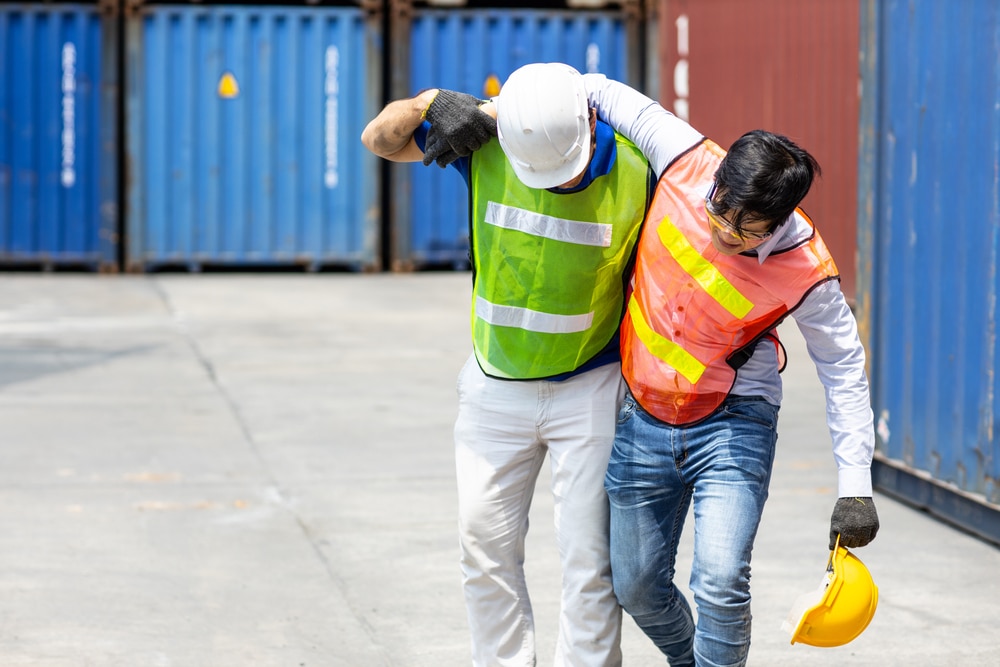Oil powers much of the world, from fueling cars and planes to heating homes and running global supply chains. But the journey from deep underground to our gas tanks and factories is anything but simple or safe.
The United States is one of the world’s top oil producers, and nowhere is that more evident than in Texas. The Permian Basin, particularly the Midland-Odessa region, is a hub of oil activity, accounting for around 30% of the nation’s total oil production. This area is packed with land-based oil rigs, high volumes of commercial traffic, and long, dangerous commutes for workers traveling to and from job sites.
While the oil and gas industry is vital to our economy, it also ranks among the most dangerous professions in the country. If you’re asking, how dangerous is oil rig work? The answer is: extremely.
The Real Risks of Working on an Oil Rig
Working on an oil rig, especially land rigs across Texas, is one of the most hazardous jobs in America. According to the U.S. Bureau of Labor Statistics, the fatal injury rate for oil and gas extraction workers in recent years was over six times higher than the national average across all industries.
From 2015 to 2022, the oil and gas industry reported 2,101 severe injuries, including amputations, loss of vision, and hospitalization, according to OSHA data. These injuries accounted for 2.6% of all serious workplace injuries across the U.S. During that same period, the International Association of Oil and Gas Producers (IOGP) reported a 36% increase in fatalities, with 20 deaths in a single year.
The dangers of oil rigs are numerous and often life-altering.
Common Oil Rig Hazards and Accidents
- Heavy Machinery and Equipment Failures
Land rigs rely on complex systems of heavy-duty machinery: rotating drill pipes, hoist blocks, tongs, spinning chains, and more. These tools are essential for drilling but pose severe injury risks.
Common causes of injury include:
- Operator error or lack of training
- Mechanical failure or equipment malfunction
- Poor machine maintenance
- Exposure to high-pressure systems
- Overloaded or tipping machinery.
These risks often lead to crushing injuries, amputations, electrocution, or being caught between equipment, one of OSHA’s top causes of oilfield fatalities.
Three out of every five oilfield deaths involve struck-by or caught-in accidents.
- Fires and Explosions
Few workplace hazards are as deadly or sudden as oil rig fires and explosions. These events are usually triggered by:
- Ignition of flammable gases like hydrogen sulfide
- Equipment overheating or electrical faults
- Static discharge or open flames
- Welding and cutting activities
- Faulty piping, valves, or leaking tanks.
Even land rigs in the Permian Basin are not immune. Fires on rigs can escalate rapidly, trapping workers and leading to severe burns, traumatic injuries, and fatalities.
From 2007 to 2020, there were 55 offshore explosions and 17 reported fires.
- Transportation and Trucking Accidents
Unlike offshore rigs, land rigs are often accessed by roads. Workers may travel long distances in fatigued conditions, early mornings, or after 12-hour shifts. The result? A higher likelihood of auto accidents, especially in regions like West Texas with heavy commercial traffic.
Injuries from oilfield trucking accidents may be just as catastrophic as those sustained on the rigs themselves, including spinal injuries, brain trauma, and wrongful death.
Related Reading: What Is Workers’ Compensation? A Guide to Workers’ Compensation for Accidents
- Exposure to Toxic Chemicals
Oil rig workers are frequently exposed to toxic chemicals and gases during drilling and extraction. These may include:
- Hydrogen sulfide (H2S)
- Volatile organic compounds (VOCs)
- Drilling mud and lubricants
- Hydrocarbon gases and vapors (HGVs).
Even short-term exposure can lead to disorientation, dizziness, burns, and difficulty breathing. Long-term exposure increases the risk of cancer, neurological disorders, and chronic respiratory conditions.
HGVs, in particular, are deadly. They can cause oxygen displacement and sudden loss of consciousness, leading to asphyxiation or death.
- Fall from Heights
Oil rig workers often perform their duties from elevated platforms, scaffolding, and ladders, where the risk of falling is high. Surfaces on rigs can become dangerously slick due to oil, mud, or rainwater, further increasing the potential for serious accidents.
When a worker falls from a height, the consequences can be devastating. Injuries may include broken bones, traumatic brain injuries, spinal damage, paralysis, or even death from blunt force trauma. Fall protection systems such as harnesses, guardrails, and safety nets are essential for preventing these incidents, yet they are not always present or properly used.
A routine day on the rig can quickly become tragic.
Related Reading: Slurred Speech after a Head Injury
Types of Injuries Caused by Oil Rig Accidents
The physical toil of an oilfield accident can be catastrophic. Common injuries include:
- Crush injuries and amputations from heavy equipment
- Spinal cord damage from falls or vehicle collisions
- Bruns and scalds from explosions or hot surfaces
- Traumatic brain injuries from falling objects
- Electrocution from faulty wiring or wet conditions
- Chemical burns from exposure to drilling fluids and vapors
- Lacerations and blunt-force trauma
- Paralysis or permanent disability
- Drowning (for offshore workers or water-based transport accidents).
These injuries may require extensive surgeries, hospital stays, and rehabilitation, costing hundreds of thousands in medical bills. Catastrophic injuries like brain trauma or paralysis can end careers, strain families, and lead to a lifetime of care.
Related Reading: What Rights Do Temporary Workers Have After Being Injured at Work?
Land Rigs vs. Offshore Rigs: What’s the difference?
While many picture offshore oil rigs surrounded by the ocean, most of Texas’s drilling takes place on land rigs. In fact, the Permian Basin has some of the highest concentrations of land rigs in the country.
Here’s how land rig dangers differ from offshore rigs:
| Hazard | Land Rigs | Offshore Rigs |
| Location | Inland or near the coast | Remote, miles from shore |
| Transportation | High risk of vehicle accidents | Helicopter or boat transport |
| Emergency Response | Quicker access to hospitals | Delayed, due to distance. |
| Work-Life Balance | Go home after shift | On-rig for weeks/months |
| Weather Risk | Storms, fog, lightning | Hurricanes, rough seas. |
| Stress and Fatigue | Long hours, local travel | Isolation, mental exhaustion. |
While both environments are hazardous, the Midland-Odessa region’s land rigs come with their own unique blend of risks, particularly vehicle crashes, equipment failures, and chemical exposure.
The Financial Costs of Oil Rig Injuries
Beyond the obvious pain and emotional trauma, injuries sustained in oilfield accidents can result in devastating financial consequences. Many workers are forced to take extended time off or leave the workforce entirely due to the severity of their injuries.
This sudden loss of income can be crippling, especially when paired with mounting medical expenses. Victims may require ongoing care, including surgeries, rehabilitation, or specialist appointments. In cases of severe injury, homes may need to be modified to accommodate mobility limitations.
Emotional distress and diminished quality of life can also affect both the injured individuals and their loved ones. These consequences are not just financial; they are deeply personal and life-changing.
How Oil Companies Can Improve Safety
Oil rig hazards are not inevitable. Many accidents are preventable with proper safety protocols and enforcement. Oil companies have a legal and ethical responsibility to protect their workers by:
- Conducting frequent safety inspections
- Offering comprehensive safety training
- Enforcing the use of personal protective equipment (PPE)
- Creating emergency response plans
- Monitoring servicing machinery and equipment
- Enforcing a rest period to avoid fatigue-related mistakes
Unfortunately, some companies cut corners, putting profit over people.
What to Do After an Oil Rig Accident
If you or someone you love has been injured in an oil rig accident, taking the right steps immediately afterward can make all the difference in your recovery, both physically and financially.
First and foremost, seek medical attention immediately, even if the injury doesn’t appear severe. Some symptoms can be delayed or worsen over time. Be sure to report the incident to your employer as soon as possible and obtain a copy of the accident report.
It’s also critical to document everything, take photos of your injury and the accident scene, collect the names of any witnesses, and keep track of all related medical visits and expenses.
Before speaking with insurance companies or agreeing to any settlements, consult with an oilfield injury attorney. These professionals understand the tactics employers and insurers use to reduce or deny claims. A skilled lawyer can advocate on your behalf, ensuring you receive the full compensation you’re entitled to.
Contact a Midland-Odessa Oilfield Injury Lawyer
The oilfields of the Permian Basin offer good jobs but also come with some of the highest risks in the country. Oil rig hazards can lead to serious, life-changing injuries that affect your ability to work, support your family, and enjoy your life.
At Patino Law Firm, we help oilfield workers and their families recover the compensation they deserve. Whether you’re facing medical bills, lost income, or ongoing pain, we’re here to support you.
You’ve worked hard in one of the most dangerous jobs in America. If your employer fails to keep you safe, you have every right to hold them accountable.
If you’ve been injured in an oil rig accident in Midland, Odessa, or anywhere in Texas, contact Patino Law Firm today.





